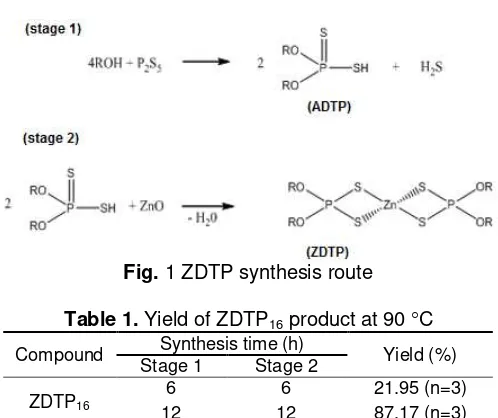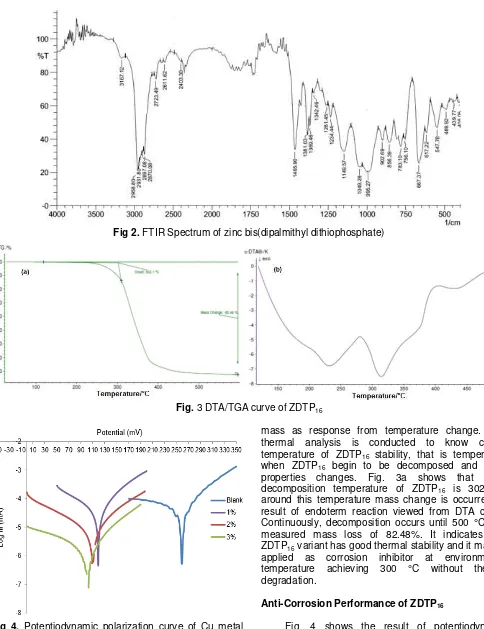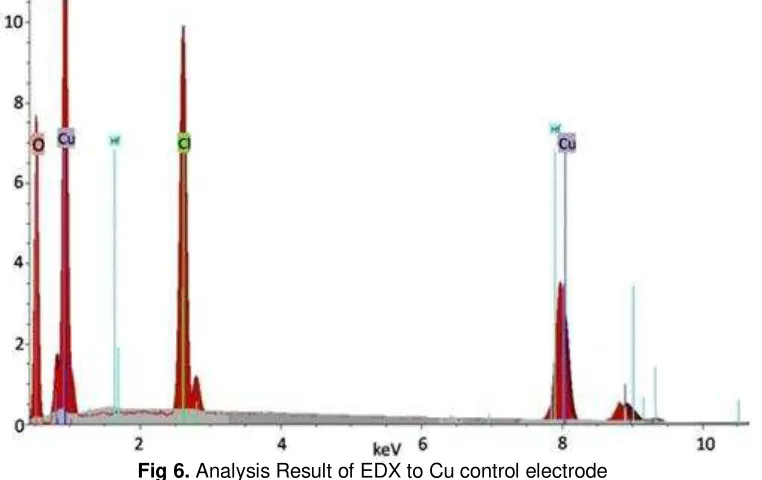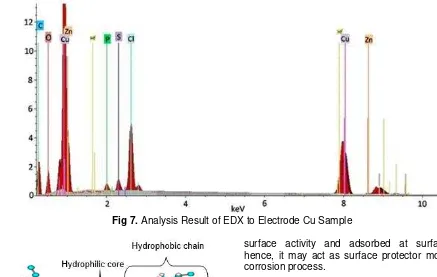Komar Sutriah et al.
* Corresponding author. Tel/Fax : +62-251-831894 Email address : [email protected]
Thermodynamic and Kinetic Study of Zinc bis-(Dipalmithyl Dithiophosphate) Activity
as Anti-Corrosion Additive-Fatty Acid Based
Through Potentiodynamic Polarization Technique
Komar Sutriah1,2,*, Zainal Alim Mas’ud1,2, M. Khotib1,2, and Denar Zuliandanu2
1Department of Chemistry, Faculty of Mathematic and Natural Sciences, Bogor Agricultural University
Darmaga Campus, Kimia Building, Tanjung Street, Bogor 16680, Indonesia
2Integrated Laboratory, Bogor Agricultural University, Baranangsiang Campus, Pajajaran Street, Bogor 16144, Indonesia
Received December 15, 2015; Accepted April 7, 2016
ABSTRACT
Zinc bis-(dipalmithyl dithiophosphate) (ZDTP16) is one product variant of zinc dialkyl dithiophosphate
(ZDTP)-fatty acid based having function as corrosion inhibitor. By using 3% of effective dose for the application, its effectiveness of ZDTP16 corrosion inhibition will achieve 97% and it will be able to decrease Cu metal corrosion rate
from 0.152 to 0.004 mm per year. Thermodynamic and kinetic parameter verification indicates the decreasing of spontaneity and corrosion rate by existence of ZDTP16 inhibitor. Gibbs free energy transition corrosion of Cu metal in
electrolyte medium is measured in corrosion simulator increased from +85.22 to +91.77 kJ mol-1, while its activation energy increased from +16.66 to +33.68 kJ mol-1. Morphology observation of Cu metal substrate surface using SEM-EDX shows that the adsorption of ZDTP16 at substrate surface is able to protect surface from corrosion indicated by
the existence of Zn, P, S, and C constituents representing composer atoms of ZDTP16, and the decreasing of Cl
-corrosive constituent at substrate surface.
Keywords: ZDTP16; adsorption; corrosion inhibitor; fatty acid
ABSTRAK
Zink bis(dipalmitylditiofosfat)(ZDTP16) adalah salah satu varian produk dari zink dialkilditiofosfat (ZDTP)
berbahan dasar asam lemak yang dapat berfungsi sebagai inhibitor korosi. Pada dosis efektif aplikasi 3%, efektivitas inhibisi korosi ZDTP16 mencapai 97% dan mampu menurunkan laju korosi logam Cu dari 0,152 ke 0,004 mm
pertahun. Verifikasi parameter termodinamika dan kinetika menunjukkan spontanitas dan laju korosi menurun dengan kehadiran inhibitor ZDTP16. Energi bebas Gibbs transisi korosi logam Cu dalam medium elektrolit yang
diukur pada simulator korosi meningkat dari +85,22 ke +91,77 kJ mol-1, sedangkan energi aktivasinya meningkat dari +16,66 ke +33,68 kJ mol-1. Pengamatan morfologi permukaan substrat logam Cu menggunakan SEM-EDX menunjukkan teradsorpsinya ZDTP16 pada permukaan substrat mampu melindungi permukaan dari korosi yang
ditunjukkan dari keberadaan konstituen Zn, P, S, dan C yang merupakan atom-atom penyusun ZDTP16, dan
menurunnya konstituen korosif Cl- pada permukaan substrat.
Kata Kunci: ZDTP16; adsorpsi; inhibitor korosi; asam lemak
INTRODUCTION
Corrosion is surface degradation process of a material as result of electrochemical reaction. Corrosion always become focus center and subject study because there are numerous damages resulted by such chemical process. Supposedly, industries and governments of USA, Australia and Japan had expended funds achieving 31% their gross domestic brutto respectively, in order to solve such problem [1]. Some infrastructures have oxidation process from contacting with water, air, and thermal accelerated corrosion process so enlarging destruction rate. Production machine with metal material
based will suffer corrosion, and it will decrease their capability for production process.
Komar Sutriah et al.
coordination complex compound. The sample of organic compound functioned as corrosion inhibitor is ascorbic acid, polyaniline, polyamide, imidazole, dithiocarbamate, and dithiophosphate [2-3], while inorganic corrosion inhibitor among them are natrium nitrite and natrium chromate [4]. Sample of coordination complex compound functioned as corrosion inhibitor is ZDTP [3]. In the beginning, numerous ZDTPs used as lubricant additive at automotive industries [5], but, then, it had been known that this compound also may act as anti-corrosion [6].
Variously, alkyl chain at ZDTP may be produced in accordance with application necessity, the different alkyl chain will give the different physicochemical properties. The increasing of alkyl chain length at ZDTP, will increase lipophility and thermal stability. For commercial lubricant oil, the most used ZDTP has alkyl chain from C4 to C10 [3]. Currently, numerous researches haven’t
already given report performance of ZDTP anticorrosion with oil/fatty acid based long alkyl chain. The proximate and ordered structure of ZDTP with long fattyalkyl chain will increase lipophility and solubility in base lubricant, and supposedly, will give better anti-corrosion performance than ZDTP generally applied in commercial lubricant oil currently.
Fatty alkyl application as lipophilic group on ZDTP is the best choice for downstream agro industry in Indonesia, because such group may be derived from fatty acid of vegetable oil such as palm oil representing superior commodity of Indonesia. Indonesia had given contribution around 51% for total palm oil production in the world, as world biggest palm oil producer. Indonesia and Malaysia had contributed around 87% palm oil production in the world or around 23% from total vegetable oil production in the world [7]. Indonesia palm oil export is around 75% from total national production, most of them (77%) are still in crude palm oil and palm kernel oil, and its remaining is intermediate products such as fatty acid and fatty alcohol [8]. Factually, it is comparative excellence in supplying raw materials for renewable vegetable oil based ZDTP agro industry development. Fatty alcohol as raw material of ZDTP may be obtained from fatty acid of palm oil conversion/reduction. By varying fatty acid/fatty alcohol type as raw material, ZDTP variants having fattyalkyl chain length difference will be obtained. Hence, the gaining of any excellent ZDTP derived from fatty acid/fatty alcohol of palm oil will become alternative for development of palm oil based downstream national superior product because it is supported by availability of abundant local raw material which will ensure supply continuity.
Performance of any anti-corrosion additive may be measured using coupon corrosion by considering coupon weight loss [9], measure and compare change of
copperstrip corrosion color [10] or potentiodynamic polarization by measuring corrosion current decrement by Tafel curve [11]. Polarization technique is more profitable from sides of fast work time, high sensitivity, and efficient corrosion process measurement. Additionally, corrosion current data obtained from this technique may be used to calculate change of Gibbs free energy (G), enthalpy (H), entropy (S), and activation energy (Ea) [2,12].
In this research, ZDTP16 is synthesized from cetyl
alcoholderived from palmitic acid, a dominant fatty acid component in palm oil. Thermodynamic and kinetic parameter of anti corrosion from ZDTP16 are calculated
from corrosion current data by potentiodynamic polarization. Morphology observation of exposed substrate surface as result of corrosion monitoring by SEM-EDX. This research is aimed to synthesize ZDTP16 from cetyl alcohol, by measuring and
quantifying its inhibition performance based on parameters of activation energy, Gibbs free energy on transition state, and change of surface morphology of Fourier Transform Infra red Spectrophotometer Prestige-2 (FTIR), Atomic Absorption Spectrophotometer of Shimadzu AA 6300 (AAS), Differential Thermal Analysis (DTA) NETZSCH TG 209F3 TGA209F3A-0257-L and Thermal Gravimetric Analysis (TGA), Scanning Electron Microscope- Electron Dispersive Xray Zeiss Evo 50 (SEM-EDX), and Potentiostat DY2300EN.
Procedure
Synthesis and characterization of ZDTP16 Product ZDTP16 synthesis is referred to Dinoiu et al. [13]
by reacting cetyl alcohol and P2S5 with mol ratio 4:1 in
n-heptane solvent (first stage reaction 1) for certain period in reactor completed with a set of H2S absorber.
Heating and stirring conducted at 90 °C at water heater. Such reaction will form dicetyl dithiophosphate acid (ADTP). As much as 1 mol ZnO is added at similar reactor to form ZDTP16. Stirring without heating
Komar Sutriah et al.
Fig. 1 ZDTP synthesis route
Table 1. Yield of ZDTP16 product at 90 C
Compound Synthesis time (h) Yield (%)
Stage 1 Stage 2
ZDTP16
6 6 21.95 (n=3)
12 12 87.17 (n=3)
n= synthesis repetition
ZDTP16 formation. ZDTP formation reaction stage from
alcohol illustrated at Fig. 1. ZDTP16 product separation functional group analysis using FTIR spectrometer, while recovery test of Zn metal in ZDTP16 product is conducted
by AAS spectrometer.
Thermal stability test of ZDTP16 product
Thermal stability monitoring is conducted by using differential thermal analysis (DTA) and thermal gravimetric analysis (TGA) instrument.
Performance of corrosion inhibition, kinetic and thermodynamic parameters
Work electrode of Cu with surface area of 2.19 cm2 is prepared by sandpapering its surface and then is washed by distilled water and acetone. Subsequently, Cu electrode is put into reservoir containing 1% of NaCl solution. Reservoir is adjusted by water circulation at its mantle in order to maintain temperature stability. Consecutively, electrode of Ag/AgCl and Pt wire installed as reference and auxiliary electrodes. The test solution (NaCl 1%) is left to achieve stability with electrode for around 5 min. And then, choose linear sweep voltammetry (LSV) in DY2300EN program at computer. Blank measurement is conducted at potential range from 0 to 400 mV with scan rate 2 mV/s. After finishing this measurement, work electrode of Cu is cleaned by washing with 5% of HCl, distilled water, and is sandpapered again. The cleaned work electrode of Cu is
then dipped in ZDTP16 solution for 15 sec and is
drained for a moment. After conditioning, sample is measured with similar potential range. Thereafter, the obtained data are processed using DY2300EN and
for calculating thermodynamic parameter by using Arrhenius equation in transition condition. The exposed Cu plate is cleaned and its surface morphology is observed by using SEM. Morphology scanning is also conducted against blank Cu electrode and Cu control electrode (Cu electrode will take corrosion treatment without ZDTP16 treatment).
RESULT AND DISCUSSION
Yield and Characterization of ZDTP16
From repeating of reaction time variation, optimum time of ZDTP16 synthesis obtained is 24 h. As
illustrated in Table 1, synthesis time of 12 h only gives yield of 21.95%, while after 24 h gives 87.17%. Besides, synthesis yield is also influenced by synthesis temperature and 90 °C is the optimum temperature for ZDTP16 synthesis reaction. According to Becchi et al.
[5] if the reaction temperature used is more than 100 °C, ZDTP product will be decomposed, hence, the yield will be low. The obtained physical form of ZDTP16 numbers indicating existence of zinc bis(dipalmithyl dithiophosphate) in ZDTP16 product. Intensity of sharp
absorption at wave number of 1467.83 cm-1 and 1377.17 cm-1 indicates vibration of –CH2- and –CH3 at
ZDTP16. The absence of absorption band at wave
number of 3500-3200 cm-1 indicates that cetyl alcohol reacted completely. The existence of P-O-C groups are indicated by absorption band at wave number of 1066-894 cm-1, while, absorption band at 667-543 cm-1 indicates the existence of P-S group [15-16], meanwhile, Zn-S group with wave number of 400-300 cm-1 was not measured.
Thermal Stability of ZDTP16
Thermal stability of ZDTP16 product is measured
Komar Sutriah et al.
Fig 2. FTIR Spectrum of zinc bis(dipalmithyl dithiophosphate)
Fig. 3 DTA/TGA curve of ZDTP16
Fig 4. Potentiodynamic polarization curve of Cu metal corrosion
mass as response from temperature change. This thermal analysis is conducted to know critical temperature of ZDTP16 stability, that is temperature
when ZDTP16 begin to be decomposed and other
properties changes. Fig. 3a shows that initial decomposition temperature of ZDTP16 is 302 °C,
around this temperature mass change is occurred as result of endoterm reaction viewed from DTA curve. Continuously, decomposition occurs until 500 °C with measured mass loss of 82.48%. It indicates that ZDTP16 variant has good thermal stability and it may be
applied as corrosion inhibitor at environmental temperature achieving 300 °C without thermal degradation.
Anti-Corrosion Performance of ZDTP16
Komar Sutriah et al.
Table 2. Influence of ZDTP16 concentration against corrosion of Cu metal in 1% of NaCl at 28 °C
Concentration
Table 3. Thermodynamic parameter and inhibitor ZDTP16 corrosion kinetic
Test solution ∆H* (kJ mol-1) ∆S* (J mol-1 K-1) ∆G* (kJ mol-1) Ea(kJ mol-1)
Blank 7.18 -257.56 85.22 16.66
Sample (3% ZDTP16) 10.68 -267.61 91.77 33.68
ZDTP16 0–3%. Seemingly, curve of Tafel anode and
Tafel catode cut each other and form straight line resulting current value and corrosion potential. By varying different application dose, corrosion current data will be obtained as illustrated in Table 2.
The higher ZDTP16 concentration, the lower
corrosion current value as well as increasing of inhibition effectiveness. This result indicates that the higher inhibitor concentration, the higher adsorbed inhibitor molecule of ZDTP16 at Cu metal interface so that the
corrosion process will undergo inhibition and resulting in lower corrosion current value.
Effectivity of Inhibition (% EI) is determined from difference of corrosion current sample and blank against blank corrosion current. Measurement result indicates inhibition effectiveness increment is in line with sample concentration increment which is comparable with surface closure degree (θ) increment. Because, the higher inhibitor molecule in solution, the possibility of molecule adsorption at metal surface will be higher physically and chemically. Corrosion rate (CR) is
obtained from weight loss measurement. The corrosion current decrement impact to corrosion rate value decrement indicating any corrosion delay. The same corrosion rate value at concentration of 2.0% and 3.0% indicates such concentration are optimal dose of ZDTP16
application for protecting Cu metal from corrosion. Thermodynamic parameter is determined based on Arrhenius equation in transition state [2]:
ln ln change of enthalpy and entropy in transition state, while NAh is Planck molar constancy (3.99 x 10−10JS mol−1).
By varying temperature (T), then, H* and S* may be determined from ln (icorr/T) vs 1/T curve, while change of
Gibbs free energy transition (G*) is calculated according to thermodynamic equation as follows:
G H T S
The ease of any reaction occurrence is depending on required minimal energy in order to run such reaction.
Activation energy may be calculated based on data plot between ln icorr and 1/T according to following Arrhenius
equation (Morad dan El-Dean 2006):
Where A is Arrhenius constancy determined empirically, Ea is activation energy of corrosion process
(kJ mol-1), R is ideal gas constancy (8.314 Jmol-1K-1), and T is temperature (K).
Table 3 shows positive value of H* and H*sample
value is higher than it’s blank. It indicates that a larger energy is required for corrosion occurrence with ZDTP16 existence at Cu metal surface. Change of
transition entropy clarifies the irregularity degree of system. The ZDTP16 inhibitor existence at system will
increase irregularity degree of system manifested by increasing of measured ∆S* [12]. ∆S*sample is higher
than its blank, although, such ∆S* increment may not be made as measurement of process spontaneity for environment ∆S* had not been determined yet. Positive value of ∆G* identifies that electrochemical process in corrosion simulation had not taken place spontaneously; hence, it requires external energy supply by electrical power. Change of Gibbs free energy transition of sample (+91.77 kJ mol-1) is more positive than blank (+85.22 kJ mol-1). It indicates that corrosion spontaneity decreased by existence of ZDTP16 as inhibitor. In other word, corrosion process
had been hindered by existence of ZDTP16 inhibitor.
Identification of kinetic corrosion manifested by activation energy parameter (Ea) obtained from curve
plot of Arrhenius ln (icorr) against 1/T. Activation energy
(Ea) obtained from declivitous curve multiplied with
ideal gas constancy (R). As illustrated in Table 3, seemingly, ZDTP16 addition influences to activation
energy increment from 16.66 to 33.68 kJ mol-1.
Surface Protection by ZDTP16
Komar Sutriah et al.
Fig 5. The SEM photograph of Cu metal surface at 1000X: prior to electrolysis/blank (a), upon electrolysis plus anti-corrosion of ZDTP16 (b) upon electrolysis without ZDTP16 addition/control (c)
Fig 6. Analysis Result of EDX to Cu control electrode
surface of Cu electrode without ZDTP16 treatment upon
electrolysis. Corrosion at Cu electrode surface had resulted in broken, wrecked, wavy, and rough surface morphology. It also illustrates the formation of metal oxides as result of corrosion process occurred, while Fig. 5b of Cu electrode which surface layered by ZDTP16 is
not exposed, no surface destruction as result of corrosion which is almost same with Fig. 5a, electrode surface prior to electrolysis (blank).
Of course, achievement of ZDTP16 in inhibiting
corrosion will be related with the ease of such molecules adsorption at surface/interface. The adsorption of ZDTP16 at Cu metal surface may be viewed from EDX
spectrum. Fig. 6 shows EDX spectrum control of Cu metal surface (without dipping in ZDTP16 solution) after
undergoing corrosion (electrolysis). Seemingly, intensity of chlorine and oxygen atom spectrum is so high indicating that corrosion process had occurred at Cu
surface with existence of chloride ion as corrosion agent derived from NaCl solution for electrolyte agent/media. The high intensity of oxygen spectrum shows corrosion process resulting oxides formation at surface. EDX result in Fig. 6 in line with SEM result at Fig. 5c showing morphology of exposed Cu electrode and oxide formation as result of corrosion.
It is different with control in Fig. 6, Fig. 7 shows analysis result of EDX against sample detecting existence of Zn, P, S, and C, other than chlorine and oxygen atom. The existence of Zn, P, S, and C atoms representing atoms composing ZDTP16 at surface of
sample electrode (by dipping at inhibitor) proven that ZDTP16 is really adsorbed at Cu metal surface/interface
Komar Sutriah et al.
Fig 7. Analysis Result of EDX to Electrode Cu Sample
Fig 8. ZDTP adsorption model at metal surface substrate
Fig. 8 shows interaction model of hydrophilic heteroatom ZDTP16 cluster adsorbed at surface of Cu
electrode acting as layer of molecular protector.
CONCLUSION
Successfully, ZDTP16 had been produced with yield
level of 87.17% at synthesis optimum time of 24 h. ZDTP16 has inhibition activity of 97% at application dose
of 3% and is able to decrease corrosion rate of Cu metal from 0.152 to 0.004 mm per year. Such power of ZDTP16
corrosion inhibition in line with achievement of its thermodynamic measurement parameter. By using Cu metal and NaCl electrolyte as target in simulator, Gibbs free energy transition corrosion had increased from +85.22 to +91.77 kJ mol-1, while its activation energy had increased from 16.66 to 33.68 kJ mol-1. Morphology
observation by substrate surface of Cu metal by using SEM-EDX strengthens proof of surface protection by ZDTP16. Existence of Zn, P, S, and C constituents
representing composer atoms of ZDTP16 and the
decreasing of Cl- as constituent corrosion at substrate surface indicates that ZDTP16 is a molecule having
surface activity and adsorbed at surface/interface hence, it may act as surface protector molecule from corrosion process.
ACKNOWLEDGEMENT
Thanks to LPPM IPB and Directorate General of Higher Education which had facilitated and financed this activity by BOPTN program of base research scheme for department and to Integrated Laboratory of IPB for facilitation, venue, and equipment so that this research may be realized.
REFERENCES
1. Revie, R.W., and Uhlig H.H., 2008, Corrosion and Corrosion Control, 4th Ed., John Wiley & Son, Inc., Hoboken-New Jersey (US).
2. Rafiquee, M.Z.A., Saxena, N., Khan, S., and Quraishi, M.A., 2008, Mater. Chem. Phys., 107 (2-3), 528–533.
3. Sangvanich, P., Tungcharoen, J., and Petsom, A., 2008, Acta Chim. Slov.,55, 582–587.
4. Ameer, M., Ghoneim, A., and Fekry, A., 2012. Chem. Mater. Res., 2 (1), 41–55.
5. Becchi, M., Perret, F., Carraze, B., Beziau, J.F., and Michael, J.P., 2001, J. Chromatogr. A, 905 (1-2), 207–222.
6. Lotfus, S., 2002, Zinc Dialkildithiophosphate Category, New York (US): The American Chemistry Council.
Komar Sutriah et al.
Production, Copra, Palm Kernel, and Palm Oil Production.
8. Sulistyanto, A.I., and Akyuwen, R., 2011, IPEDR, 4, 281–289.
9. ASTM G1-72, Recommended Practice for Preparing, Cleaning, and Evaluating Corrosion Test Specimens.
10. ASTM D130-10, Standard Test Method for Corrosiveness to Copper from Petroleum Products by Copper Strip Test.
11. ASTM G59–97, 2014, Standard Test Method for Conducting Potentiodynamic Polarization Resistance Measurements.
12. Morad, M.S., and El-Dean, A.M.K., 2006, Corros. Sci., 48 (11), 3398–3412.
13. Dinoiu, V., Florescu, D., and Bogatu, L., 2007, Rev. Chim., 58 (2), 183–185.
14. Perez, N., 2004, Electrochemistry and Corrosion Science. 2nd Ed., Kluwer Academic Publishers, New York (US).
15. Vyas, S.P., 2013, J. Chem. Pharm. Res., 5 (2), 270–278.



